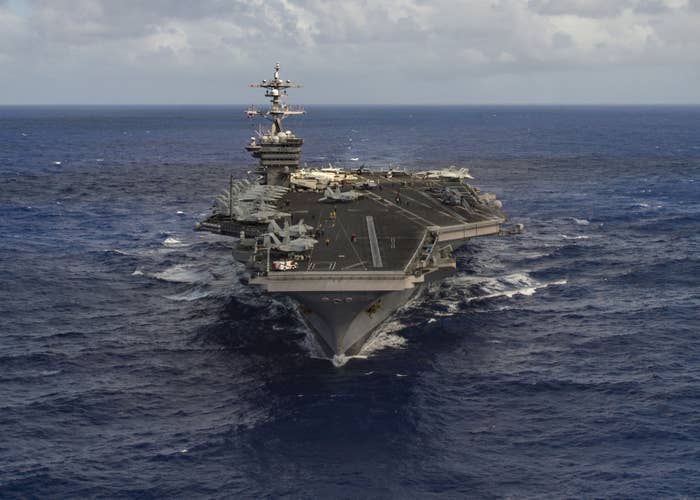
The White House has spun three major military actions as part of a broader messaging strategy against North Korea — from bombings in Syria and Afghanistan to the deployment of an aircraft carrier to the Sea of Japan. The only problem? It may not be true.
The administration claims the moves were designed to warn North Korea off testing a nuclear weapon. Vice President Mike Pence said in South Korea on Monday: “Just in the past two weeks, the world witnessed the strength and resolve of our new president in actions taken in Syria and Afghanistan. North Korea would do well not to test his resolve or the strength of the armed forces of the United States in this region.”
The Pentagon has presented the moves differently. Both the 59 Tomahawk missiles that landed on an air base in Syria following a chemical weapons attack that killed more than 70 people, and the aptly nicknamed 21,000-pound “mother of all bombs” (MOAB) that landed in Afghanistan, were tactical decisions, the Pentagon said at the time.
“Pence is trying to capitalize on things that are not connected. And basically, trying to make that into a policy when it is not,” said Lawrence Korb, a senior fellow at the Center of American Progress who worked in the Pentagon during the Reagan administration. “That’s the problem. They don’t have a policy.”
But can strikes evolve into policy? The Pentagon appears divided. As one defense official told BuzzFeed News: “It’s not our job to come up with policy.”
Another defense official said that while the moves may not have been designed as deterrents to North Korea, which is moving closer to nuclear-capable warheads and missiles, they may have that effect. The use of a weapon like the one dropped in Afghanistan — the largest non-nuclear weapon in the US arsenal, formally known as the GBU-43/B Massive Ordnance Air Blast — will always be interpreted by foes, whether or not that was the commander’s intention.

Some critics, and even Pentagon officials, see an administration assigning broader messages to military campaigns after the fact, an approach designed to substitute for a lack of policy. Others said that messaging is defined by how military action is interpreted, not as it is intended. And North Korea sees an unpredictable president willing to use military force as deterrence.
The White House said the deployment of the USS Vinson carrier group to the Sea of Japan earlier this month was intended to send a message to the North Koreans in the run-up to a suspected missile test. White House spokesman Sean Spicer called the deployment “deterrence [and] presence. It’s prudent.” But Pentagon officials privately said Adm. Harry Harris, the US Pacific Command commander, made the decision independently. The US military intended for USS Vinson to be a “show of force," not a prudent move for potential military action.
As it turns out the carrier group was headed in the opposite direction, some 3,500 miles away, as the New York Times reported on Tuesday, despite the White House declaration — the Vinson was never planned to be anywhere near the Sea of Japan until the end of the month.
Publicly, the Pentagon spelled out specific tactical reasons for both Afghanistan and Syria strike campaigns and limited those to the countries hit.
Secretary of Defense Jim Mattis has never publicly tied the Syria strike to a message to North Korea. The strike in Syria was “a measured military response [that] could best deter the regime” of Syrian President Bashar al-Assad from using of chemical weapons on his own people, he said during an April 11 Pentagon press briefing.
Nor did Trump make any mention of his intention to send a broader message to the world community following the Syria strike. He came closest when he said it “is in this vital national security interest of the United States to prevent and deter the spread and use of deadly chemical weapons.” But even that, at the time, was interpreted as a legal justification for striking a Syrian air base, not part of a broader strategy directive.
And the US used the MOAB to take out ISIS bunkers because it was the most effective weapons against such an entrenched, remote target, according to Army Gen. John Nicholson, who ordered the strike.In a press conference held after the strike, Nicholson said it “demonstrates the commitment of Afghan forces, Afghan government and U.S. partners to defeat” ISIS. He made no mention of North Korea.
Nicholson’s decision to deploy the MOAB was made by Nicholson, commander of the war in Afghanistan, with little input from Washington.
The split between words and action have fed a climate of unpredictability in Trump’s foreign policy, which is something he campaigned on. And some say even if the actions were not designed to send a message, they might anyway.
“The signal is sent by the use of force,” Daveed Gartenstein-Ross, a senior fellow at the Foundation for Defense of Democracies, told BuzzFeed News. “Messages can be heard independent of the intentions of the sender.”
One of those messages came from the fact that Trump recently said he had given his commanders “total authorization” to make battlefield decisions without always checking in with the White House.
That decision to trust the commanders alone is a message to US adversaries — as much as the decision those commanders then make, Gartenstein-Ross said.
That is, even if the US military did not intend to send a broader message, it cannot control how its actions are inevitably interpreted. Speculation on whether the Syria strike was really a message to North Korea, he noted, began immediately after the strike was over.
North Korea also saw a connection, putting out a statement about the Syria strike with an unnamed spokesman for the Foreign Ministry calling it a “clear and unforgivable act of aggression against a sovereign state and we strongly condemn this," according to the state news agency, KCNA.
